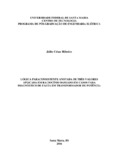| dc.creator | Ribeiro, Júlio César | |
| dc.date.accessioned | 2021-12-24T12:14:54Z | |
| dc.date.available | 2021-12-24T12:14:54Z | |
| dc.date.issued | 2016-03-29 | |
| dc.identifier.uri | http://repositorio.ufsm.br/handle/1/23406 | |
| dc.description.abstract | Considering the operator’s difficulty in classifying and diagnosing the fault, this article presents the results obtained through Three Values Annotated Paraconsistent Logic (3vAPL) in Case-based Reasoning (CBR) in order to identify different types of faults in the Electrical Power Systems. The faults’ classification and identification have the alarms - associated with the triggering of protection relays - as information basis. After the shutting down of the electrical network for protection, it is up to the operator to select the most relevant messages, to extract a conclusion based on the available data and to suitably act towards the reestablishment of the energy. For the work in question, protection is constituted of five relays, being: differential 87, Buchholz 63, restricted earth fault relay 64, phase overcurrent 51, timed and neutral overcurrent, timed 51N. The five relays generate 32 operation possibilities; only five of them are known. The five known operations compose a matrix (5x5) called Knowledge Basis. the functioning of the 3vAPL in CBR uses the Modified Cosine Matching Function (MCMF) to establish a similarity degree (Gcas) between the Knowledge Basis and the other 27 unknown combinations. From the Gcas, it is possible to identify the events of the 27 combinations through the 3vAPL in CBR. Aiming at validation, the results have been compared to those obtained through the Bayes theorem. The tests have been carried out based on the protection scheme of Power Transformers (PT), which are formed of five protection functions. The results show that the proposed model presents a performance that is superior to that of the Generalized Neural Network (GRNN). Finally, the results of this work show that the 3vAPL in CBR, when compared to the GRNN Neural Networks, present a superior result, besides showing a 100% assertiveness when compared to the classification and identification table of faults by the Bayes theorem | eng |
| dc.language | por | por |
| dc.publisher | Universidade Federal de Santa Maria | por |
| dc.rights | Attribution-NonCommercial-NoDerivatives 4.0 International | * |
| dc.rights.uri | http://creativecommons.org/licenses/by-nc-nd/4.0/ | * |
| dc.subject | Proteção | por |
| dc.subject | Redes neurais | por |
| dc.subject | Classificação de faltas | por |
| dc.subject | Diagnóstico de faltas | por |
| dc.subject | Protection | eng |
| dc.subject | Neural network | eng |
| dc.subject | Faults’ classification | eng |
| dc.subject | Diagnosis of faults | eng |
| dc.title | Lógica paraconsistente anotada de três valores aplicada em raciocínio baseado em casos para diagnóstico de falta em transformador de potência | por |
| dc.title.alternative | Three values annotated paraconsistent logic applied in case based reasoning for fault diagnosis in power transformers | eng |
| dc.type | Dissertação | por |
| dc.description.resumo | Em vista da dificuldade do operador em classificar e diagnosticar a falta, este trabalho apresenta os resultados obtidos da Lógica Paraconsitente Anotada de Três Valores (LPA3v) em Raciocínio Baseado em Casos (RBC), para classificar e identificar diferentes tipos de faltas no Sistema Elétrico de Potência. A classificação e identificação das faltas têm, como base de informações, os alarmes associados ao disparo dos relés de proteção. Após o desligamento da rede elétrica por ação dos relés de proteção, cabe ao operador selecionar as mensagens mais relevantes; extrair uma conclusão a partir dos dados disponíveis e agir apropriadamente no sentido de restabelecer a energia. No trabalho em questão, a proteção é constituída por cincos relés: diferencial 87, Buchholz 63, relé de proteção de terra restrito 64, sobrecorrente de fase 51, temporizado e sobrecorrente de neutro, temporizado 51N. Os cinco relés geram 32 possibilidades de operações; dentre elas, apenas cinco são conhecidas. As cinco operações conhecidas compõem uma matriz (5x5) chamada de Base de Conhecimento. O funcionamento da LPA3v em RBC utiliza a Função Casamento de Cosseno Modificado para estabelecer o grau de similaridade entre a Base de Conhecimento com as outras 27 combinações desconhecidas. A partir do Grau de Casamento (Gcas), é possível identificar os eventos das 27 combinações através da LPA3v em RBC. A fim de validação, os resultados foram comparados com aqueles obtidos a partir do teorema de Bayes. Os testes foram realizados com base no esquema de proteção de Transformadores de Potência (TDP), sendo esse constituído pelas cinco funções de proteção. Os resultados mostram que o modelo proposto apresenta desempenho superior à Rede Neural de Regressão Generalizada (RNRG). Por fim, os resultados deste trabalho mostram que a LPA3v em RBC, quando comparada com as Redes Neurais GRNN, apresenta resultado superior, além de apresentar uma assertividade de 100% comparada com a tabela de classificação e identificação das falta do teorema de Bayes. | por |
| dc.contributor.advisor1 | Cardoso Junior, Ghendy | |
| dc.contributor.advisor1Lattes | http://lattes.cnpq.br/6284386218725402 | por |
| dc.contributor.referee1 | Araújo, Olinto César Bassi de | |
| dc.contributor.referee2 | Fritzen, Paulo Cícero | |
| dc.creator.Lattes | http://lattes.cnpq.br/9307581340965790 | por |
| dc.publisher.country | Brasil | por |
| dc.publisher.department | Engenharia Elétrica | por |
| dc.publisher.initials | UFSM | por |
| dc.publisher.program | Programa de Pós-Graduação em Engenharia Elétrica | por |
| dc.subject.cnpq | CNPQ::ENGENHARIAS::ENGENHARIA ELETRICA | por |
| dc.publisher.unidade | Centro de Tecnologia | por |



